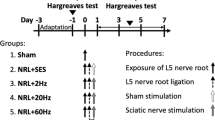Abstract
Objective
To explore the effect of electroacupuncture (EA) on the pathomorphology of the sciatic nerve and the role of P2X3 receptors in EA analgesia.
Methods
The chronic constriction injury (CCI) model was adopted in this study. A total of 32 rats were randomly divided into four groups: sham CCI, CCI, CCI plus contralateral EA (CCI + conEA) and CCI plus ipsilateral EA (CCI + ipsEA). Mechanical withdrawal threshold (MWT) and thermal withdrawal latency (TWL) were measured. EA began at day 7 after the CCI operation and was applied to the Zusanli (ST 36) and Yanglingquan acupoints (GB 34). At day 14, the pathomorphologic changes of the operated sciatic nerve were demonstrated by hematoxylin and eosin staining. In addition, dorsal root ganglion (DRG) neurons isolated from rats were examined by electrophysiological recording to determine if the P2X3 receptor agonists, adenosine 5′-triphosphate disodium (ATP) and α,β-methylen-ATP (α,β-meATP) evoked inward currents.
Results
Pain thresholds in the CCI group were obviously decreased post CCI surgery (P<0.01). In the EA groups, thermal and mechanical threshold values were increased after the last EA treatment (P<0.05, P<0.01). There was no significant difference in light microscopic examination among the four groups (P>0.05). Current amplitude after application of ATP and α,β-meATP in DRG neurons were much larger in the CCI group compared to those obtained in sham CCI (P<0.05). ATP and α, β-meATP invoked amplitudes in the CCI + EA groups were reduced. There was no signififi cant difference between the CCI + conEA group and the CCI + ipsEA group (P>0.05).
Conclusion
EA analgesia may be mediated by decreasing the response of P2X3 receptors to the agonists ATP and α,β-meATP in the DRG of rats with CCI. No pathological changes of the sciatic nerve of rats were observed after EA treatment.
Similar content being viewed by others
References
Jiang SH, Yang GH, eds. Clinical research and application of acupuncture and tuina. Beijing: People’s Medical Publishing House;2008:121–126.
Burnstock G. Historical review: ATP as a neurotransmitter. Trends Pharmacol Sci 2006;27:166–176.
Abbracchio MP, Burnstock G, Verkhratsky A, Zimmermann H. Purinergic signalling in the nervous system: an overview. Trends Neurosci 2009;32:19–29.
Burnstock G. Physiology and pathophysiology of purinergic neurotransmission. Physiol Rev 2007;87:659–797.
Burnstock G. Acupuncture: a novel hypothesis for the involvement of purinergic signalling. Med Hypotheses 2009;73:470–472.
Lau WK, Lau YM, Zhang HQ, Wong SC, Bian ZX. Electroacupuncture versus celecoxib for neuropathic pain in rat SNL model. Neuroscience 2010;170:655–661.
Sun S, Cao H, Han M, Li TT, Zhao ZQ, Zhang YQ. Evidence for suppression of electroacupuncture on spinal glial activation and behavioral hypersensitivity in a rat model of monoarthritis. Brain Res Bull 2008;75:83–93.
Patel S, Naeem S, Kesingland A, Froestl W, Capogna M, Urban L, et al. The effects of GABA(B) agonists and gabapentin on mechanical hyperalgesia in models of neuropathic and inflammatory pain in the rat. Pain 2001;90:217–226.
Fox A, Kesingland A, Gentry C, McNair K, Patel S, Urban L, et al. The role of central and peripheral Cannabinoid1 receptors in the antihyperalgesic activity of cannabinoids in a model of neuropathic pain. Pain 2001;92:91–100.
Zhang A, Xu C, Liang S, Gao Y, Li G, Wei J, et al. Role of sodium ferulate in the nociceptive sensory facilitation of neuropathic pain injury mediated by P2X(3) receptor. Neurochem Int 2008;53:278–282.
Ou S, Zhao YD, Xiao Z, Wen HZ, Cui J, Ruan HZ. Effect of lappaconitine on neuropathic pain mediated by P2X3 receptor in rat dorsal root ganglion. Neurochem Int 2011;58:564–573.
Estebe JP, Myers RR. Amitriptyline neurotoxicity: dose-related pathology after topical application to rat sciatic nerve. Anesthesiology 2004;100:1519–1525.
Kim MK, Choi TY, Lee MS, Lee H, Han CH. Contralateral acupuncture versus ipsilateral acupuncture in the rehabilitation of post-stroke hemiplegic patients: a systematic review. BMC Complement Altern Med 2010;10:41.
Goldman N, Chen M, Fujita T, Xu Q, Peng W, Liu W, et al. Adenosine A1 receptors mediate local anti-nociceptive effects of acupuncture. Nat Neurosci 2010;13:883–888.
Bennett GJ, Xie YK. A peripheral mononeuropathy in rat that produces disorders of pain sensation like those seen in man. Pain 1988;33:87–107.
Novakovic SD, Kassotakis LC, Oglesby IB, Smith JA, Eglen RM, Ford AP, et al. Immunocytochemical localization of P2X3 purinoceptors in sensory neurons in naive rats and following neuropathic injury. Pain 1999;80:273–282.
Kennedy C, Assis TS, Currie AJ, Rowan EG. Crossing the pain barrier: P2 receptors as targets for novel analgesics. J Physiol 2003;553(Pt 3):683–694.
Burnstock G. Pathophysiology and therapeutic potential of purinergic signaling. Pharmacol Rev 2006;58(1):58–86.
Chen Y, Shu Y, Zhao Z. Ectopic purinergic sensitivity develops at sites of chronic nerve constriction injury in rat. Neuroreport 1999;10:2779–2782.
Gao Y, Xu C, Liang S, Zhang A, Mu S, Wang Y, et al. Effect of tetramethylpyrazine on primary afferent transmission mediated by P2X3 receptor in neuropathic pain states. Brain Res Bull 2008;77:27–32.
Burnstock G. Physiology and pathophysiology of purinergic neurotransmission. Physiol Rev 2007;87:659–797.
Dunn PM, Zhong Y, Burnstock G. P2X receptors in peripheral neurons. Prog Neurobiol 2001;65:107–134.
Author information
Authors and Affiliations
Corresponding author
Additional information
Supported by the National Natural Science Foundation of China (No. 30901924)
Rights and permissions
About this article
Cite this article
Cheng, Rd., Tu, Wz., Wang, Ws. et al. Effect of electroacupuncture on the pathomorphology of the sciatic nerve and the sensitization of P2X3 receptors in the dorsal root ganglion in rats with chronic constrictive injury. Chin. J. Integr. Med. 19, 374–379 (2013). https://doi.org/10.1007/s11655-013-1447-1
Received:
Published:
Issue Date:
DOI: https://doi.org/10.1007/s11655-013-1447-1




